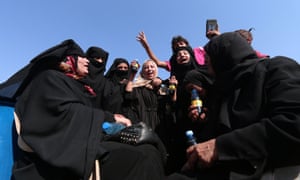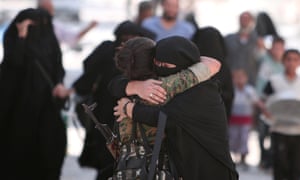Una ragazza cammina con le donne che sono state evacuate dai vigili del Forze democratiche siriane dalla città Iside-controllato di Manbij, Siria. – Reuters
A girl walks with women who were evacuated by Syrian Democratic Forces fighters from the Isis-controlled city of Manbij, Syria. Photograph: Rodi Said/Reuters
Un portavoce delle Forze Democratiche siriane (SDF) sostenute dagli Stati Uniti ha dichiarato che la città di Manbji è stata ripresa dopo la fuga, venerdì, degli ultimi militanti di Iside. Secondo la SDF e l’Osservatorio siriano per i diritti umani, gli ostaggi liberati erano stati usati come “scudi umani”.
Londra – Sono stati liberati i 2.000 ostaggi nelle mani dell’Isis in ritirata da Manbji, città siriana al confine con la Turchia. Ne dà notizia il Guardian* (leggi sotto: (More than 2,000 Isis hostages freed from Syrian city of Manbij) citando come fonti la Coalizione arabo-curda sostenuta dagli Stati Uniti e l’Osservatorio siriano dei diritti umani. Intanto, sui social scorrono le immagini della gioia della popolazione di Manbji, sotto il giogo del Califfato fino al giorno dell liberazione: le donne fumano liberamente, vengono improvvisati roghi di burqa e gli uomini si fanno fotografare mentre si fanno tagliare la barba, imposta dalla ideologia dello Stato Islamico.
I miliziani dell’Isis, ha riferito l’Osservatorio siriano per i diritti umani, hanno abbandonato la città a bordo di 500 auto, dirette verso nord-est, a Jarablus, ancora sotto il controllo del Califfato. Ieri le ‘Forze democratiche siriane’ (Sdf nell’acronimo) avevano annunciato di aver lanciato la fase finale dell’offensiva per liberare Manbijn, concentrandosi in modo particolare nel quartiere settentrionale di al Sarb, dove si erano rifugiati i miliziani dell’Is. Oggi la città appare nel pieno controllo della coalizione.I combattenti dell’Is avevano utilizzato come scudi umani i civili per scappare. “Dall’inizio della campagna (militare) lo Stato islamico ha usato i civili come scudi umani per nascondersi. Abbiamo preso tutte le misure necessarie per garantire la sicurezza del nostro popolo. Lo consideriamo una priorita’ e abbiamo preso tutte le precauzioni necessarie per proteggere i civili da qualsiasi attacco”, si legge in una nota del Consiglio militare di Manbij, organismo creato per la supervisione delle operazioni.
Finora le Sdf, milizie curdo-arabe in cui la parte curda delle Ypg (Unita’ di protezione del popolo) è preponderante, hanno salvato oltre 170 mila civili a Manbij secondo il comunicato. Le Sdf avevano gia’ lanciato tre ultimatum ai miliziani dello Stato islamico per liberare gli ostaggi in cambio dell’apertura di un corridoio per consentire loro di lasciare la citta’. Lo Stato islamico però ha rifiutato le offerte. “Per questo non abbiamo avuto scelta che portare avanti un’operazione militare per riprendere gli ostaggi e sconfiggere l’Is. Questa sarà l’ultima cruciale operazione per la liberazione di Manbij”, concludeva il comunicato diffuso ieri, 12 agosto.
La liberazione di Manbji costituisce un duro colpo anche per il sistema basato sui foreign fighters: “I membri dell’Isis”, ha spiegato alla Bbc il capo curdo-siriano Salih Muslim, “bnon saranno piu ”n grado di viaggiare per e dall’Europa”.
Dal Guardian
* More than 2,000 Isis hostages freed from Syrian city of Manbij (Guardian)
Allied Arab and Kurdish fighters retake Syrian city from retreating jihadis, where men, women and children had been held as human shields
The Islamic State stronghold of Manbij, in northern Syria, has fallen to allied Arab and Kurdish fighters, who freed more than 2,000 hostages held there by the terrorist group.
A spokesman for the US-backed Syrian Democratic Forces said they had taken over the city after the last Isis militants fled on Friday. According to the SDF and the Syrian Observatory for Human Rights, the freed hostages had been used as “human shields”.
Sharfan Darwish of the SDF-allied Manbij military council told Reuters: “The city is now fully under our control but we are undertaking sweeping operations.”
Pentagon deputy press secretary Gordon Trowbridge said: “Although fighting in Manbij continues, Isil is clearly on the ropes. It has lost the centre of Manbij, it has lost control of Manbij.”
The Arab-Kurdish alliance had expelled most of the Isis fighters from Manbij by last week but dozens continued to put up a tough resistance until Friday.
The abductions took place as Russian and Syrian jets pounded rebel positions in and around Aleppo, killing at least 20 people, a spokesman for the Syrian Observatory for Human Rights said.

Prior to their withdrawal from Manbij, the Isis fighters abandoned a northern neighbourhood, taking the captives with them. They headed for the town of Jarabulus, along the border with Turkey, which their forces hold.
“While withdrawing from a district of Manbij, Daesh [Isis] jihadis abducted around 2,000 civilians from Al-Sirb neighbourhood,” said Darwish. “They used these civilians as human shields as they withdrew to Jarabulus, thus preventing us from targeting them,” he said, adding that women and children were among those taken.
The Britain-based Syrian Observatory for Human Rights, which relies on sources inside Syria to cover the war, gave a similar report, saying Isis forced about 2,000 civilians into cars it confiscated and headed for Jarabulus.
The jihadis, who have suffered a string of recent losses in Syria and Iraq, have often staged mass kidnappings in the two countries when they come under pressure to relinquish territory.
In January Isis abducted more than 400 civilians, including women and children, as it overran parts of Deir Ezzor province in eastern Syria. It later released about 270 of them.
Isis has used civilians as human shields, booby-trapped cars and carried out suicide bombings to slow advances by their opponents and avoid coming under attack. Thousands of civilians were held captive by the group in Fallujah, which Iraqi forces recaptured in June after a four-week offensive.

On Friday the Site intelligence group said Isis had killed five men in Iraq for smuggling people out of territory it controls.
With air support from the US-led coalition, the SDF began its assault on Manbij on 31 May, surging into the town three weeks later. The offensive was slowed by a big jihadi fightback, before a major push last week saw the alliance seize 90% of the town.
Tens of thousands of people lived in Manbij before the assault started. The United Nations has said that more than 78,000 people have been displaced since then.
Manbij was strategically significant because it was on Isis’s supply route from the Turkish border to Raqqa, the de facto capital of its self-styled Islamic “caliphate”.
The Observatory said the battle for Manbij claimed the lives of at least 437 civilians – including 105 children – and killed 299 SDF fighters and 1,019 jihadis.
The observatory said women and children were among at least 20 people killed on Friday in Syrian and Russian air raids on rebel positions in Aleppo and rebel positions further north and west of the city. Twelve were killed in Hayyan, a small town 15km (10 miles) north of Aleppo, it said.
An AFP correspondent in the rebel-held east of the city said several neighbourhoods were hit, adding that people had been out on the streets to stock up on supplies after weeks of shortages caused by a punishing government siege.
Syria’s state news agency, Sana, quoting a military source, said the warplanes destroyed several rebel positions and vehicles and killed “dozens of terrorists”. The Observatory said clashes raged between rebels and pro-regime forces south of Aleppo.
Friday’s raids took place despite a pledge by Russia to observe a three-hour daily ceasefire in Aleppo to allow for humanitarian aid deliveries. An estimated 1.5 million people live in the city, including about 250,000 in rebel-held districts.
Syria’s conflict erupted in March 2011. Since then more than 290,000 people have been killed and and world powers have been drawn in on all sides of the war.
vivicentro.it/cronaca – Stanislao Barretta, da agenzia Agi e da Guardian







